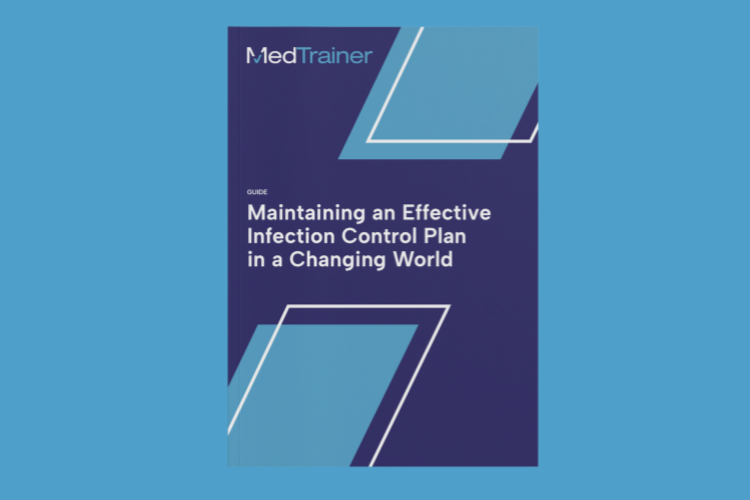Bloodborne pathogens (BBPs) are disease-causing microorganisms that can pose significant health risks to healthcare workers and patients. Ensuring compliance with the California Division of Occupational Safety and Health (CAL OSHA) regulations is essential to prevent exposure to these infectious agents.
Let’s discuss bloodborne pathogens, CAL OSHA, its implications for healthcare facilities, and how MedTrainer can streamline the compliance process.
Understanding Bloodborne Pathogens
BBPs are infectious microorganisms in human blood and other body fluids that can cause diseases such as Hepatitis B, Hepatitis C, and Human Immunodeficiency Virus (HIV). Healthcare workers are at increased risk of exposure to these pathogens due to the nature of their work, which often involves direct contact with blood and body fluids. Therefore, it’s crucial to implement effective preventive measures to minimize the risk of exposure and transmission.
Take a deeper dive into infection control plans in this free ebook.
What is CAL OSHA?
The California Division of Occupational Safety and Health, or CAL OSHA, is a regulatory body that enforces health and safety laws in California. It aims to protect workers from occupational hazards like exposure to bloodborne pathogens (BBP).
CAL OSHA enforces the Bloodborne Pathogens Standard (Title 8 CCR, Section 5193), which outlines the requirements for employers to establish an Exposure Control Plan and follow specific practices to minimize the risk of BBP exposure in the workplace.
Potential Routes of Exposure to Bloodborne Pathogens for Healthcare Workers
Healthcare workers have the highest risk of exposure to BBPs than any other profession. That’s why it’s crucial for everyone on staff to have access to training and resources to prevent BBPs as much as possible.
Here are some of the most common ways a healthcare provider can contract a BBP:
- Needlestick injuries: Accidental puncture wounds from needles or other sharp objects contaminated with blood or body fluids can transmit BBPs.
- Cuts and abrasions: Workers may be exposed to BBPs if they sustain cuts or abrasions from contaminated sharp objects, such as scalpels, broken glass, or exposed bone fragments.
- Splash exposure: BBPs transmit through splashes of blood or other potentially infectious materials (OPIM) that come into contact with a worker’s mucous membranes (eyes, nose, or mouth) or non-intact skin (open wounds, cuts, or rashes).
- Direct contact: Healthcare workers may be exposed to BBPs through contact with blood, body fluids, or contaminated surfaces, especially if they have non-intact skin or open wounds.
- Aerosol exposure: In some procedures, such as dental work or certain laboratory tasks, aerosols containing blood or other potentially infectious materials (OPIM) may be generated, posing a risk of BBP exposure through inhalation or contact with mucous membranes.
- Improper handling of contaminated materials: Healthcare workers may be exposed to BBPs if they mishandle contaminated items, such as soiled linens, used dressings, or waste materials.
- Human bites: Although rare, bites from infected patients can transmit BBPs if the bite breaks the skin.
- Laboratory accidents: Workers handling blood samples, body fluids, or tissues can come in contact with BBPs through spills, splashes, or broken containers.
To minimize the risk of exposure to BBPs, healthcare facilities must implement thorough preventive measures, including appropriate engineering controls, work practices, personal protective equipment, and regular employee training. Compliance with regulations such as the CAL OSHA Bloodborne Pathogens Standard helps protect your staff from these occupational hazards.
Compliance Requirements for Healthcare Facilities
Healthcare facilities must adhere to CAL OSHA regulations to ensure the safety of their employees and patients. Some of the essential requirements include the following:
- Establishing an Exposure Control Plan: This plan outlines the procedures for identifying employees at risk of bloodborne pathogens and implementing appropriate engineering controls, work practices, and personal protective equipment (PPE) to minimize exposure risks.
- Training and Education: Employers must provide regular training to employees with the potential for occupational exposure to bloodborne pathogens. This training should cover the modes of transmission, prevention measures, and the facility’s Exposure Control Plan.
- Recordkeeping: Administrators must maintain accurate records of employee training, exposure incidents, and the results of evaluations and follow-up procedures. There are many ways to keep track of compliance, but we recommend this one.
- Hepatitis B Vaccination: Employers must offer the Hepatitis B vaccine series to all employees with potential occupational exposure, free of charge.
- Post-Exposure Evaluation and Follow-Up: Employers must have a procedure to provide confidential medical evaluations and follow-up care for employees who experience exposure incidents.
Streamlining Compliance with MedTrainer
MedTrainer offers a comprehensive solution to help healthcare facilities meet and maintain compliance with CAL OSHA regulations related to bloodborne pathogens. Our platform provides your hospital administration with the following:
- Customizable Exposure Control Plans: Our platform allows you to create a tailored Exposure Control Plan that meets the specific needs of your facility and adheres to CAL OSHA requirements.
- Online Training Courses: MedTrainer offers a wide range of online courses, including Bloodborne Pathogens training, to help educate your staff on the risks and preventive measures associated with BBP exposure.
- Centralized Recordkeeping: Our platform streamlines the process of maintaining employee training records, exposure incidents, and medical evaluations, making it easy to stay organized and compliant.
- Compliance Management: Stay up-to-date with CAL OSHA regulations and ensure your preparedness for inspections and audits.
MedTrainer is Your Partner in CAL OSHA Compliance
Adhering to CAL OSHA regulations is essential for protecting healthcare workers and patients from the risks associated with bloodborne pathogens. Healthcare facilities can effectively minimize exposure risks and maintain a safe working environment by implementing an Exposure Control Plan, providing proper training, and utilizing comprehensive compliance management tools like MedTrainer.
Stay informed, stay compliant, and safeguard the health of your employees and patients. Schedule your demo today.
